Saltmarshes
Introduction
Saltmarshes are the most common geomorphologic
form in the Lagoon; nowadays they cover the 8% of its surface, compared
to a 25% at the beginning of the century (from Various authors, “La
Laguna di Venezia”, CIERRE, Verona, 1995).
According to Boerio (1856), their name comes from “baro”,
the vernacular term indicating a thick group of bushes or an uncultivated
marshy land.
They look like a flat and small island, whose substrate is mainly made
up of silt-clayey sediments (from Rallo G., “Guida alla natura nella
Laguna di Venezia - Itinerari, storia e informazioni naturalistiche”).
Saltmarshs are constantly visible, except when the tide rises. High tide
represents the limiting
factor to their vegetal
association in terms of salinity,
water availability, lighting, etc.
Other systems characterising the saltmarshs
are the ghebi,
the velme, the chiari,
the paciare.
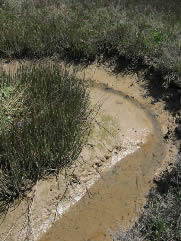 The
velme are shallow beds that emerge only when the tide lowers.
Several types of phanerogams
characterise the velme:Cymodocea
nodosa, Zostera
noltii, Zostera marina.
Particularly, the Zostera marina dwells in the external velme, the velme
fronting the Lagoon waterways; the Zostera noltii characterises the internal
velme, those fronting the marshes. The
velme are shallow beds that emerge only when the tide lowers.
Several types of phanerogams
characterise the velme:Cymodocea
nodosa, Zostera
noltii, Zostera marina.
Particularly, the Zostera marina dwells in the external velme, the velme
fronting the Lagoon waterways; the Zostera noltii characterises the internal
velme, those fronting the marshes.
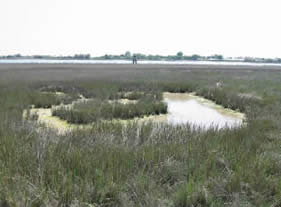 The chiari and the paciare
sono delle depressioni are ground depressions where salty water accumulated
during high tide mixes with meteoric
water, thus forming small lakes. These environments go on developing
and come out from the dynamic balance of sediments, currents, and vegetation.
The chiari and the paciare
sono delle depressioni are ground depressions where salty water accumulated
during high tide mixes with meteoric
water, thus forming small lakes. These environments go on developing
and come out from the dynamic balance of sediments, currents, and vegetation.
Saltmarshes are crucial in the fight against
eustacy: the plants growing on them catch sediments and debris,
thus making the soil thicker and taller.
Saltmarshes typologies
Saltmarshes are classified according to
both the ways they have been formed and their own evolution. Each kind
of saltmarsh is characterised by a stratification of sediments and the
zonizing of the distinctive vegetation.
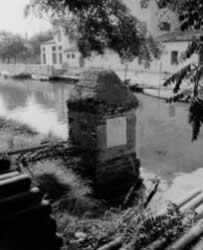 Lagoon
edge saltmarshes Lagoon
edge saltmarshes
Some saltmarshes are the remaining visible part of the coastal plain.
They are so permeated with salty water that only the halophyle
vegetation, adapted to such an inhospitable environment, can
grow on them.
This kind of saltmarshes are located along the Lagoon edge towards the
mainland, like the ones between Campalto and the Dese area. These saltmarshes
show their nature through some continental indicators that can be detected
both on the surface and few centimetres in depth.
Originally saltmarshes were directly influenced by the mainland, which
continuously provided sediments and plants. When the lagoon
boundary stopped the sediments provision, a demolition process
began.
Internal
areas saltmarshes
The saltmarshss sited in the internal parts of the Lagoon have had a more
complex history. They were initially wetted by salty waters; later on,
due to the rivers flowing into the Lagoon, they started developing fresh
water marshes and peat-bog.
Eventually, after the waterways were diverted towards the sea (see: deflection
of the Lagoon tributaries), they reassumed Lagoon features.
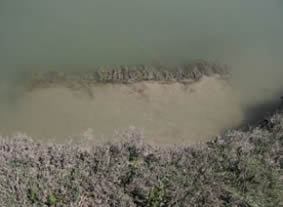
They are mostly sited in the South Lagoon,
between Marghera and Chioggia. The lack of sediments provision, caused
by waterways diversion, brought to a graduate lowering of saltmarshes,
worsened by the erosion
due to wave
motion and to the subsidence.
The history of this kind of saltmarshes can be traced back through the
underground sediments: in fact, stratigraphy
underlines the succession of the Lagoon indicators - indicators of fresh
environment - saltmarshes indicators - indicators of Lagoon environment.
Saltmarshes along
the old tributaries to the Lagoon
Another kind of saltmarshes can be found along the old waterways
flowing into the Lagoon and they were formed by ancient drifts.
On the maps of the Lagoon, they are often indicated by the phrase “points
of the lovi”, the word “lovo” probably coming from “alluvium”
(flood), thus revealing their origin. As they are easily accessible from
the mainland, they have been often turned into agricultural fields.
Saltmarshes
along the Lagoon waterways
The saltmarshes along the Lagoon waterways have a different origin: they
were formed by sediments brought about by the marine current; because
of their slow flowing speed, the sediments dropped some suspension material.
A smaller amount of sediments come from the erosion caused by the marine
current on the canals beds.
They can be considered original ecotopes
, as they have been only slightly influenced by man. Consequently,
their flora and fauna, as well as the sediments structure and its dynamisms,
have not altered their original features much.
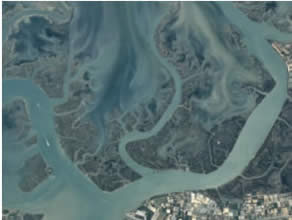 This
kind of saltmarsh is typical of the North Lagoon (S. Erasmo, San Felice,
San Lorenzo, and Burano) where many sediments are dropped after flowing
into the Lagoon from the Lido lagoon inlet by a reduced current speed. This
kind of saltmarsh is typical of the North Lagoon (S. Erasmo, San Felice,
San Lorenzo, and Burano) where many sediments are dropped after flowing
into the Lagoon from the Lido lagoon inlet by a reduced current speed.
The edge of these saltmarshes is taller on the side of the supplying canal,
while it becomes shorter as it moves away from it, turning into a velma.
Even in this case the underground sediments reveal the evolution of the
place: at the beginning of the stratigraphic series a large amount of
Lagoon indicators can be detected, but gradually they are replaced by
saltmarshes indicators.
This type of saltmarsh cannot be found in the Malamocco and Chioggia lagoon
inlets, because the water flowing into them does not carry an amount of
sediments large enough to form" Lagoon waterways saltmarshes".
The main problem affecting this kind of saltmarshes is the erosion given
by the wave
motion due to heavy water traffic.
Paleo
saltmarshes
In the Venice Lagoon there are also some paleo saltmarshes, whose long-lasting
presence has been proved by traces of oxidation
and of developing vegetal remains: their appearance was not
due to a storage of sediments but to the lowering of the sea level (from
Cavazzoni S., “La Laguna: origine ed evoluzione“ in “La
Laguna di Venezia“, CIERRE, Verona, 1995 and from Favero V., Serandrei
Barbero R., “Origine ed evoluzione della laguna di Venezia. Bacino
meridionale“, in “Lavori, vol. 5, Venetian Society of Natural
Sciences, Venice, 1980).
Being characterised by three association
of perennial
plants (Spartineto, Limonieto, Puccinellieto) saltmarshes
vegetation is stable.These associations can exploit environmental resources
at their best without turning into more complex ones. An excessive salinity,blocking
the vegetation natural series, prevents their coming to a climax
(from Pignatti S., “La vegetazione alofila della laguna veneta“).
Saltmarshes
zonation
Despite their origin, three different
layers can be distinguished in the saltmarshes, corresponding to three
levels of elevation.
- Low
saltmarshes: they are slight downwards
slopes linking the velma to the proper saltmarsh.
They host the Spartinetum strictae, a vegetal association
which is mainly formed by the saltmarshes common cord grass (Spartina
maritima) and, to a lesser extent, by glasswort (Sarcocornia
fruticosa), sea lavender (Limonium
narbonense), and puccinellia (Puccinellia
palustris). 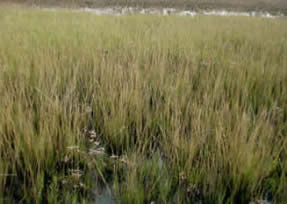
The low saltmarsh salinity is quite high
(25 – 35 ‰), its terrain loose, rich in organic
matter , and soaked in water. Vegetal association is stable;
as a matter of fact, both the sea lavender and the common cord grass of
the saltmarshes are perennial plants, thus exerting their consolidating
action in an efficient and ongoing way.
The glasswort is said to be a pioneer
plant, since it is the first to grow in the velme.
It starts consolidating the sediments that will host the common cord grass,
the real stabiliser of the saltmarshes.
- Medium saltmarshes:their
typical association is the Limonietum venetum. According to Pignatti (1966),
about the 90% of saltmarsh surface is covered by this vegetal association.
It is composed of sea
lavender, glasswort,
puccinellia,
annual sea-blite (Suaeda
marittima), sea aster (Aster
tripolium), sea rush (Juncus
maritimus).
This biodiversity
is really important for the defence of saltmarshes as different species
can use environmental resources in various ways, thus assuring a consolidating
vegetal presence in any condition.
The soil on which the limonietum grows must be clayey, very moist
or even soaked, not much airy, with a high salinity, and periodically
submerged by high tide.
- High
saltmarshes: The most common plant in
the area is the Puccinellieto, an association characterised by the Puccinellia,
a bushy and perennial plant that would be cut and used as fodder for domestic
animals. This area of the saltmarsh is flooded only when the tide rises.
Here saline concentration is higher than the one in the low saltmarsh,
even though the lower part is periodically submerged. There are a couple
of reasons for this:
- when the tide rises, salty water floods the saltmarsh, evaporates, and
concentrates;
- salty water percolates through ground holes from the water
table and gradually evaporates while reaching the surface.
Once on the surface, its salinity is higher than that of seawater. The
longer the rising process is, the more water evaporates and the higher
saline concentration is. This is the more probable explanation.
Adaptation
of organisms
Plants
Saltmarshes plants show an adaptation
ability that makes them survive in such a peculiar environment.
One of the main problems for plants living in these places is water absorption,
which occurs by osmotic
pressure difference: therefore, water moves from where the
concentration of solutes is low towards an
area where their concentration is higher.
Saltmarshs salt concentration is quite high, thus preventing plants from
absorbing water from the ground.
Saline concentration in the tissue of halophyle
plants can even reach a 10%; this makes the absorption of
water and of nutritional substances possible. Salt storage and the photosynthesis
occur in the branches, being salicornia leaves extremely short or even
absent.
Other adaptation features are:
- a vegetative part which is poorly developed and very short in order
to resist wind;
- well developed roots to absorb as much nourishment as they can from
such a dry and salty terrain;
- flowers set in small niches not to let the wind scatter pollen.
Sea lavender stem and leaves have glands that release extra salt.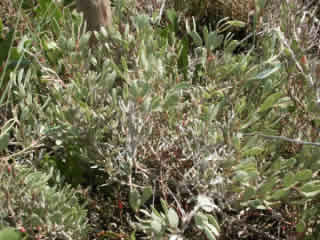
The sea purslane (Halimione
portulacoides) leaves, like those of other plants, are
succulent
or small to limit water loss caused by evapotranspiration.
In the saltmarshs there are some depressions, like the chiari and the
paciare, where salty water mixes with meteoric
water thus diminishing salinity. These less prohibitive conditions
let also the wigeongrass (Ruppia
marittima), grow; it provides important nourishment for
the common coots (Fulica
atra) and anatidae. In fact,
saltmarshes are inhabited by limicolous birds, particularly in winter
and in the migration time. The anatidae coming from North European countries
find a favourable climate and spend the winter here.
Invertebrates
Some terrestrial invertebrates adapted to this environment by adopting
special strategies: some insects dig tunnels in the substrate, breathing
in air bubbles while immersing in the saltmarsh; some others follow the
tide flow and shelter on top of the plants when the tide rises; they get
back to the soil when the tide lowers (da Torricelli P., Bon M., Mizzan
L., “Aspetti naturalistici della laguna e laguna come risorsa”
Parte Prima: Aspetti naturalistici della laguna).
|



